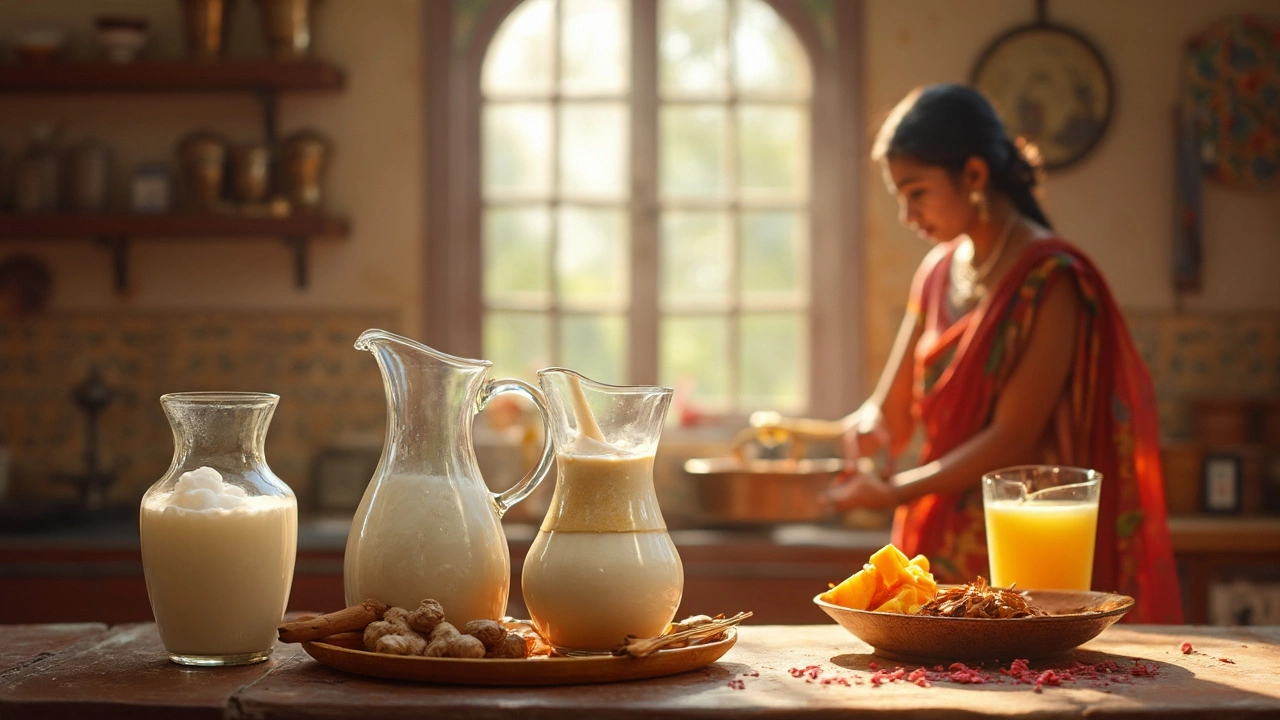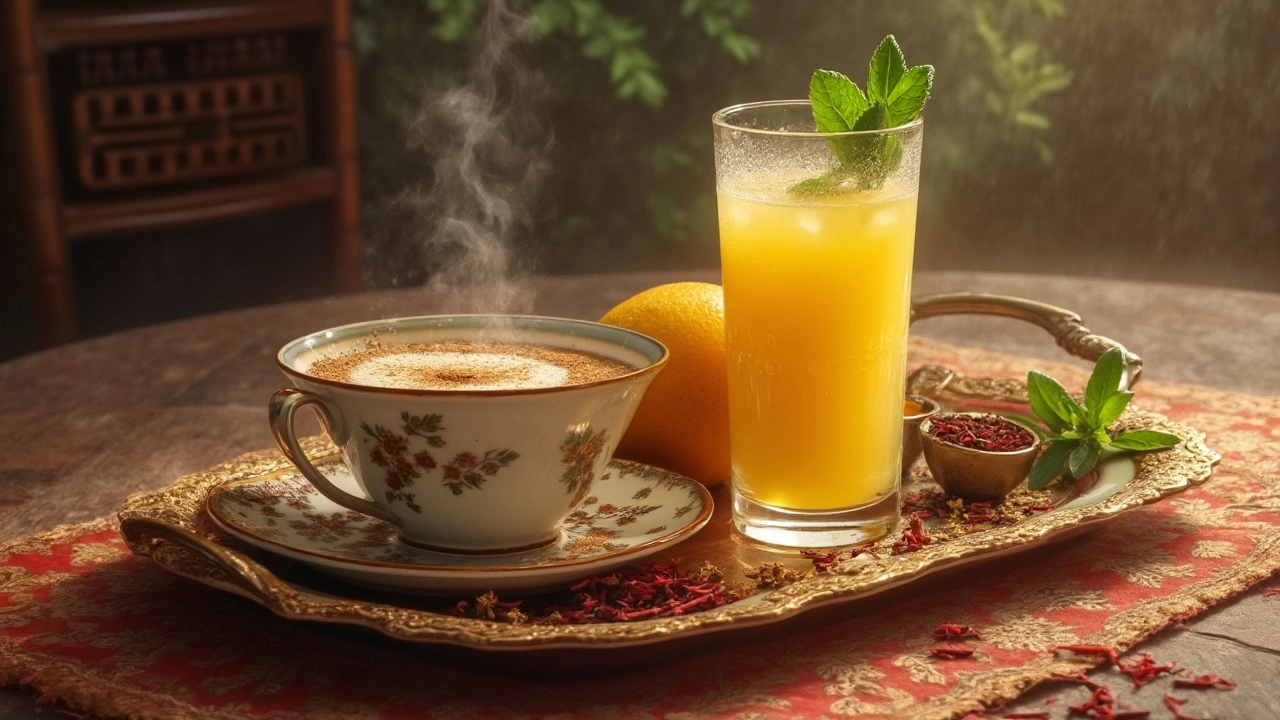Exploring Milk Choices in India: A Delicious Journey
 Mar, 26 2025
Mar, 26 2025
In India, milk is practically its own food group, and you’ll find it in a variety of forms in kitchens across the country. We’re not just talking about your regular cow’s milk. There's also buffalo, goat, and even camel milk, each bringing its own taste and benefits to the table. So, whether you’re whipping up a traditional chai or a rich kheer, knowing your milk can make all the difference.
Most Indians prefer cow or buffalo milk, and it often depends on the region. For instance, in the north, buffalo milk is popular for its rich, creamy texture. It’s perfect for making thick, decadent dishes. Meanwhile, in the south, cow milk reigns supreme, thanks to its lightness. And let's not forget camel milk, mostly found in Rajasthan—it's got a unique taste that's slowly gaining popularity for its nutritional perks.
- Popular Milk Types in India
- Traditional Milk-based Drinks
- Milk in Indian Cuisine
- Choosing the Right Milk for Recipes
Popular Milk Types in India
When it comes to milk in India, diversity is the name of the game! Among the top choices, cow milk and buffalo milk take the lead in both popularity and consumption. These aren't just random picks either—they're deeply rooted in regional preferences and culinary traditions.
Cow Milk
Cow milk is pretty much the all-rounder in the Indian milk scene. Its lighter taste and texture make it a staple in everyday tea, coffee, and countless recipes. It’s highly digestible, which is why it’s particularly favored by children and older folks. Plus, it’s loaded with calcium and vitamins, supporting bone health – a win-win!
Buffalo Milk
Now, if you prefer something richer and creamier, buffalo milk is your go-to. It's a heavy hitter thanks to its high fat content. This makes it perfect for indulgent desserts like kheer or for adding body to curries and gravies. Buffalo milk is especially popular in states like Uttar Pradesh and Punjab, where taste and texture are paramount.
Goat Milk
While not as mainstream, goat milk is gaining traction for its unique taste and health benefits. It’s easier to digest than cow or buffalo milk because of its smaller fat globules and slightly lower lactose levels. You might spot it in health-conscious circles and niche markets across India.
Camel Milk
Camel milk might sound exotic, but in Rajasthan, it's a local favorite. Despite its distinct taste, it’s been praised for being rich in iron, vitamin C, and immune-supporting antibodies. It's not your everyday milk, but if you’re in the neighborhood, give it a try!
Table: Milk Nutritional Comparison
| Type | Fat Content (%) | Protein (g per cup) |
|---|---|---|
| Cow Milk | 3.5 | 8 |
| Buffalo Milk | 6-8 | 9 |
| Goat Milk | 4.5 | 8 |
| Camel Milk | 2-3 | 8 |
With these varied milk types, you're not just choosing a drink—you're picking a backdrop for flavors and experiences unique to Indian cuisine.
Traditional Milk-based Drinks
India is a paradise for milk lovers, thanks to its wide array of traditional milk-based drinks. These beverages are not only delicious but are also a part of India's rich culinary heritage.
Masala Chai
Masala chai, or spiced tea, is perhaps the most famous milk-based drink from India. Made with strong black tea, a mix of spices, and milk, it's a perfect blend of flavors. Here's how you can make it:
- Bring water to boil with some black tea leaves.
- Add spices like ginger, cardamom, and cinnamon.
- Let it simmer for a few minutes before adding milk.
- Sweeten to taste with sugar and enjoy piping hot!
This drink is a staple in every household and is served to guests as a gesture of hospitality.
Lassi
Moving on, we have lassi—a refreshing yogurt-based drink that's perfect for beating the heat. Originating from Punjab, it’s served sweet, salted, or flavored with fruits.
To make a simple sweet lassi, blend together yogurt, sugar, and a hint of cardamom. For a fruity twist, add mango pulp to create mango lassi—an internationally loved variant.
Badam Milk
Next up is badam milk, a soothing almond-flavored drink. It's usually served warm and is known for its calming properties. To make it, soak almonds overnight, blend them into a paste, and mix with boiled milk flavored with saffron and cardamom.
Thandai
During festivals like Holi, thandai is a must. This festive drink combines milk with nuts, seeds, and spices, offering a rich palette of flavors. It's intricately tied to celebrating auspicious events.
| Drink | Main Ingredients |
|---|---|
| Masala Chai | Black Tea, Spices, Milk |
| Lassi | Yogurt, Sugar/Fruits |
| Badam Milk | Almonds, Milk, Cardamom |
| Thandai | Milk, Nuts, Seeds, Spices |
These traditional Indian milk drinks not only enhance meals but also offer a sneak peek into India's diverse culture. Next time you crave something new, try making one of these at home!

Milk in Indian Cuisine
If you've ever dabbled in Indian cooking, you know milk is the secret behind so many beloved dishes. Whether it's a sweet dessert or a savory curry, milk finds its place, adding a richness that’s hard to beat. But what makes it special is how versatile it is across different recipes and regions.
Rich Sauces and Creamy Curries
In North India, where dairy is a cornerstone, you'll find comfort foods like paneer butter masala and creamy koftas relying heavily on buffalo milk. Its thick consistency enhances cream-based dishes, giving them a luscious texture. Buffalo milk’s richness means you might often skip adding cream.
Sweet Desserts
India's renowned for its sweets, and milk steals the show in most of them. Classics like rasgulla, made from cow milk chenna, or the irresistible kheer, a rice pudding simmered slowly in milk, demonstrate how this ingredient is essential for authentic flavors. And don't forget lassi, the sweet yogurt drink perfect for cooling down spicy meals.
Everyday Staples
Milk isn't just for special occasions. It’s in everyday staples like curd and paneer, adding a nutritional boost to any meal. Curd rice or a paneer tikka wrap for lunch? Yes, please! Indian recipes often emphasize keeping the base ingredients fresh, making a trip to a local dairy a routine for many.
| Milk Type | Common Uses |
|---|---|
| Cow Milk | Kheer, Rasgulla, Paneer |
| Buffalo Milk | Creamy Curries, Ghee |
| Camel Milk | Specialty Dishes |
Whether it's a special festive meal or a simple everyday dish, milk is there to enhance textures and flavors, making every bite memorable. So, next time you're trying an Indian recipe, consider the type of milk you’re using—it could be the game-changer in your dish!
Choosing the Right Milk for Recipes
India's variety of milk options can be overwhelming, but picking the right milk is essential for nailing your favorite Indian recipes. Whether you're going for a creamy korma or a refreshing lassi, the milk you choose can either make or break your dish.
Understanding the Types
First things first—know your milk. Cow's milk is a versatile choice found almost everywhere in India. It's light and has lower fat content, which makes it great for tea and smoothies. Buffalo milk, on the other hand, packs a punch with its creaminess and is ideal for thickening curries or making paneer.
Regional Preferences
Regional preferences play a huge role in choosing milk. Up north, buffalo milk is often the go-to for its rich texture, especially in desserts like rabri and rasgulla. Down south, cow's milk is more common and used in lighter dishes. In the west, especially Gujarat, dessert lovers swear by the creaminess of buffalo milk for sweets like shrikhand.
Specialty Milks
Don't overlook the specialty camel milk. While not as widely available, it’s gaining traction thanks to its health benefits. Rich in vitamins and minerals, camel milk is ideal for those seeking a low-calorie option, though its unique taste might take some getting used to.
Quick Tips for Cooking
- Always consider the dish's flavor profile. If you want creaminess, go for buffalo milk. For lighter dishes, cow milk is your best friend.
- Experiment with a mix. Some recipes benefit from a combination, like using buffalo milk for thickness and cow milk for lightness.
- When in doubt, taste as you go! Milk can change the texture and flavor, so make small batches to test.
Every region has its favorites when it comes to milk, making this culinary journey as diverse as India's culture itself. Remember, the right milk can transform an ordinary meal into an extraordinary one.
